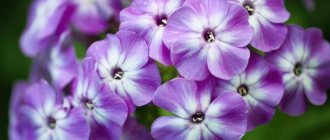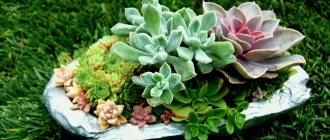Peonies
Peonies can decorate any garden or flower bed. This bush flowering plant produces a lush head of beautiful massive buds and rich greenery. Peonies are great for cutting and making bouquets.
There are many varieties of peony, the flowers of which are colored not only in the traditional pink color, but also in burgundy and white. You can get acquainted with the most original varieties of this tall perennial in the article below.
Shirley Temple
Perhaps the most beautiful white peony. Its buds are especially lush, semi-double. The diameter of the bud exceeds 20 cm. The delicate flower exudes a pleasant, unobtrusive aroma. The peduncles of the Shirley Temple variety are very stable and durable. Their height exceeds 1 m, but gartering and installation of supports for the bush are not required. The flower variety is resistant to partial shade and does not require special care. It can be grown on any soil, however, peony is very grateful for feeding, increasing the quantity and improving the quality of flowers.
Important! A young peony begins to bloom only after 2-3 years. At first, the buds of the Shirley Temple variety are colored soft pink, but over time their color turns white.
In addition to the above variety, white flower color is characteristic of the following varieties: “Festiva Maxima”, “Top Brass”, “White Wings”, “Pecher”.
Charles White
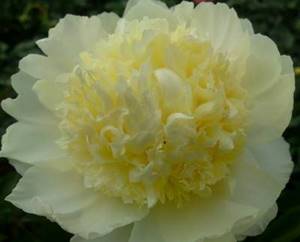
"Charles White" is the only peony of its kind that has a cream color. Its upper petals are curled, brighter, and colored lemon-cream. The buds of the "Charles White" variety are very large, more than 20 cm in diameter. They are well suited for cutting and making bouquets. Flowers exude a pleasant, sweet aroma.
Peonies of this variety are quite tall; the bush can reach 1.2 m. The plant is distinguished by its increased resistance to diseases and frosts.
Important! The Charles White variety is one of the most expensive compared to other types of peony.
Sarah Bernhardt
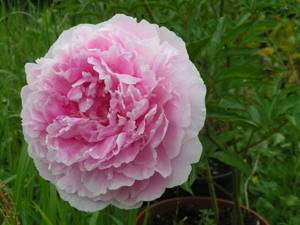
The "Sarah Bernhardt" variety stands out among other pink peonies due to its particularly delicate flower color. Semi-double, large buds exude a very strong aroma that will attract the entire area. These perennial flowers, like other peony varieties, are tall. The length of the peduncle exceeds 100 cm. However, thanks to the strong, stable stems, the bush holds its shape well and does not need support.
In addition to the “Sarah Bernhardt” variety, the varieties “Nymph” (has a cup-shaped bud with a yellow core), “Pink Hawaiian”, “Raspberry Sandae”, “Solange”, “Edens Parfum”, “Jadwiga” and some others will delight you with pink buds.
Red Charm
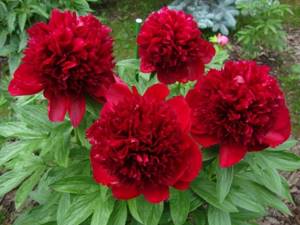
A very beautiful blood red peony. Its buds are semi-double and quite large. The plant is resistant to lack of light, prolonged frosts and diseases. The flowers are tall: the length of the peduncle exceeds 80 cm. Peonies of the “Red Charm” variety are excellent for making bouquets.
The varieties “Red Magic”, “Peter Brand” and some others can please with similar red flowers.
Sorbet
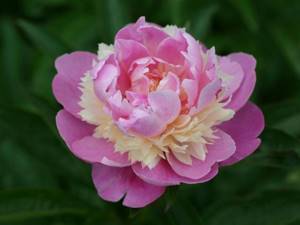
A tall flower whose bush exceeds 1 m. Its uniqueness lies in the combination of pink and cream colors. Such beautiful buds can surprise and delight even experienced gardeners. The buds of this variety have a wonderful delicate aroma. They can be used to make bouquets.
Peony is one of the most common tall perennials that can be found in almost every garden. It is undemanding in care, annually produces a huge number of beautiful buds, the color variety of which is very extensive. With the help of peonies you can decorate your lawn, flower bed, and front garden. The flowering period of these beautiful giants occurs in June-July. Preparing peonies for wintering involves cutting off the green mass and covering the plants with peat or mulch. It is recommended to feed flowering bushes once every 2 years. Plants should be replanted every 5-6 years. All the nuances associated with planting and growing peonies can be found in the video:
Phloxes
Phloxes are great for decorating flower beds. They can be planted in the center of the composition, along the perimeter of which low-growing flowers will be located. This combination is excellent, since phloxes are not prone to flattening and keep their shape well.
There are a huge number of phloxes, the color of which varies from white to purple. You can see the most beautiful of them below.
Neon Jade
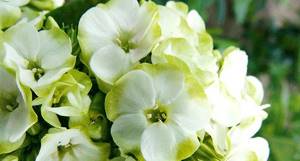
Excellent, tall phlox, the color of which combines white and green shades. This color is exotic for the culture and can surprise the most sophisticated gardeners. The height of the flowers of this variety reaches 70 cm. The plants are light-loving and have a negative attitude towards high soil moisture.
Peppermint Twist
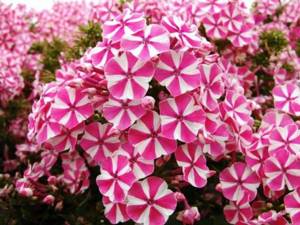
An excellent phlox, the height of which exceeds 90 cm. Its especially bright flowers involuntarily attract the attention of every person passing by. The stunning sweet honey aroma enhances the attraction and beckons you to come closer.
The flower stalks of this plant are strong and stable. Phloxes do not require a garter. A large number of inflorescences are formed on each peduncle. The small flowers of this variety combine white and light red sectors.
Cyclamen
Phlox variety "Cyclamen" is distinguished by especially large flowers. They are painted bright red. On the surface of the petals there is a small raspberry-colored eye. Plant height exceeds 90 cm.
Important! The uniqueness of the variety lies in its late flowering period. Phloxes of the “Cyclamen” variety will decorate the area, while other flowering plants are at the stage of withering.
Blue ocean
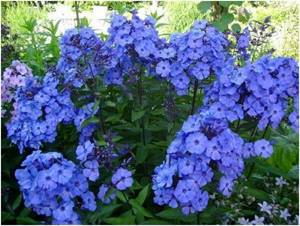
You can create a pond on your site using phlox of the “Blue Sea” variety. This flower has a unique color that changes throughout the day: in bright sunlight, the flowers are purple-lilac; with sunset, the phloxes acquire a blue tint.
A bush of phlox variety “Blue Sea” can be seen above in the photo. It is quite durable and stable, not prone to flattening. The height of the perennial exceeds 70 cm.
In botany, there are about 100 different varieties of perennial phlox, it is not possible to describe each of them, but the most unique of them are listed above. It is not difficult to grow them; they are undemanding in terms of soil nutrition and regular watering. Many gardeners grow these tall perennials because they are able to delight with their beauty for a long time. Phlox blooms from June to August. Late varieties can surprise with their beauty until October. Plants are prepared for winter: cut and covered with insulating materials. Some other nuances associated with growing phlox are shown in the video:
Dahlias
Scientists have identified more than 50 thousand different varieties of dahlias. Among them there are low, medium and tall species. There are annual and perennial dahlias with different colors, shapes and flower size. Even experienced flower growers are not always able to understand such diversity, so we will try to highlight some varieties that are especially popular.
Duet
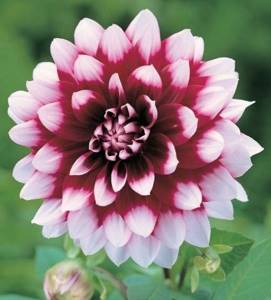
Dahlias of the "Duet" variety are perennial, tall flowering plants, the buds of which are very bright and quite large. The height of the green bush of the “Duet” variety exceeds 1 m. The diameter of the flowers is at least 18 cm. They are formed on the main stems and side shoots of the plant. A special feature of the variety is the color of the flowers, which combines the main bright color of the petals with a delicate white tip.
Important! Dahlias of the “Duet” variety can be burgundy, orange, red (photo above), yellow.
Nallmark
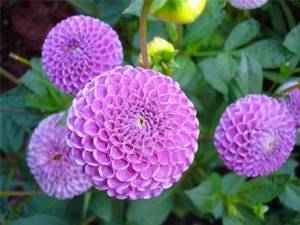
Globular dahlias have always been particularly popular among gardeners. One of these varieties is “Nallmark”, the buds of which are colored blue or light purple. This variety is characterized by strong, durable peduncles that reliably hold a large number of dense flowers. The diameter of each Nallmark bud is 3-5 cm. These flowers are excellent for garden decoration and cut bouquets.
Dahlia

Cactus dahlia, the petals of which are like needles. The color of the buds of this variety may vary. So, in the above photo, yellow and red colors are amazingly combined. The size of the flowers of such a dahlia can vary from 4 to 20 cm, the height of the bushes from 1.5 to 2 m. The parameters of the plant and the abundance of flowering depend on the growing conditions. So, to get a beautiful, lushly flowering bush, you need to regularly feed and water the perennial plant.
Similar to the variety “Dahlia” is the perennial variety “Veritable”, a photo of which can be seen below.

Arabian night
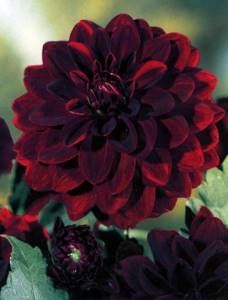
The uniqueness of this variety lies in the dark red color of the flowers. In some cases, Arabian Night perennial flowers can be almost black. Their petals are slightly curled and pointed. Tall bushes are demanding of light, moisture, and feeding. They can decorate a vegetable garden, a garden, or a separate flower bed. The height of the plant exceeds 1 m. It must be tied up. The diameter of the buds of this dahlia variety exceeds 15 cm.
Important! Dark red Arabian Night dahlias look great in bouquets and retain their freshness for a long time when cut.
Tall, perennial dahlias can be a wonderful decoration for any yard, and what is especially pleasing is that there is no need to carefully care for the plants. So, having planted dahlias once, you can forget about them for several years, only admiring the wonderful flowers in the summer. Dahlias do not require regular watering or loosening of the soil. These wonderful plants bloom at the end of summer, until the onset of the first frost. As soon as the climate temperature drops below -50C, the bushes need to be cut off. The roots can be pulled out of the soil, dried and stored. In regions that are not characterized by harsh winters, you can avoid digging up the roots of dahlias, covering them with a thick layer of peat and mulch. Geotextiles can also be used as insulation material.
Important! The root system of perennial dahlias successfully withstands temperatures down to -100C.
With the onset of spring warmth, the artificial cover from the plants must be removed and the bulk fertile layer slightly raked. If the roots have been dug up for the winter, they should be planted in the soil in May.
Purple sapling
In addition to the well-known perennial flowers listed above, there are other beautiful representatives of the flora. Thus, among the tall, perennial flowering plants, it is worth highlighting “Purple Poskonnik”.

This tall plant blooms from July to August. The height of its bushes varies from 80 to 150 cm. It can be planted in the background of a flower bed in combination with low-growing plants or as an independent garden decoration. It can also be used to decorate ponds, fences and as a hedge. The tall flowers of the perennial "Purple Poskonnik" are pale pink. The stems of the plant are strong and hold their shape well. In the general landscape, the flowers look like a light, soft pink cap.
This rare perennial is propagated by cuttings or seeds. Planting of plants of this variety must be done in early spring. During the growing process, the flower is demanding of moisture, but at the same time it is not afraid of even the most severe frosts and does not require shelter for the winter.
Types of tall perennial flowers
When planning to plant tall flowering perennials, you need to choose the most suitable options. Not only the external attractiveness, the flowering period, but also the growing conditions are taken into account. The choice is made in accordance with the soil on which flowering tall perennials will grow.
Attention! When planting several species, care should be taken into account. Moisture-loving and drought-resistant plants should not be planted nearby.
Buzulnik
A tall flowering perennial plant is used to visually divide the area. Buzulnik can become a hedge or screen. Up to 150 species of this flowering plant are found in nature, but about 10 varieties are used for decorative purposes.
In the summer-autumn period, the jagged buzulnik pleases with yellow attractive buds. The plant grows up to 1 m in height.
The tallest is Przhevalsky's buzulnik. This is a yellow tall perennial. Its height is about 2 m. Its flowers are small and yellow in color. They are collected in narrow inflorescences 50–70 cm long. The leaves of Przhevalsky's buzulnik are distinguished by their decorative appeal. They are heart-shaped. In spring and summer the leaves are green, and in autumn they turn purple-crimson.
Buzulnik loves abundant watering. It can be safely planted near bodies of water. This plant is shade-loving. It is allowed to plant it in the shade of houses, fences, and trees.
It grows well in any soil, but it will flower profusely if planted in moist, fertile soil. This tall perennial is not afraid of frosts; it tolerates them calmly even without shelter. It will delight plot owners with flowering without replanting for decades.
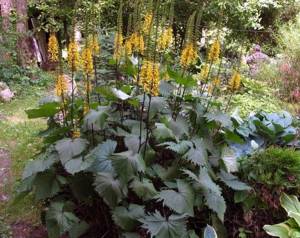
Astilbe
Popular among many summer residents, it is an unpretentious perennial. Astilbe has a long flowering period. It is best to plant it in shaded areas, although some species grow well in direct sunlight.
Astilbe grows up to 1 meter in height. She loves soils with high humidity and needs frequent watering. You cannot wait for the soil to dry completely; in drought or prolonged hot weather, this tall garden perennial with bright flowers may die.
Comment! Experienced flower growers advise planting astilbe so that it is in the shade under the crowns of trees, but at some distance from their roots.
Chinese astilbe blooms throughout the summer; clusters of inflorescences of blue, white, pink, and purple colors are formed on the plant. Astilbe Thunberg blooms in July, it produces inflorescences in the form of racemose panicles, they are colored white or pink.
This tall perennial propagates by dividing the bush, buds, and seeds.

Mallow
The flowers are also known as hollyhock roses. Depending on the variety, they bloom in May-June, July-August or throughout the summer. From June until the end of August, the pink hollyhock delights with its attractive buds.
Mallows are sun-loving perennials. But they can also bloom in shaded areas. Stock roses need to be watered sparingly; they are drought-resistant. These perennial flowers tolerate winter well and are not afraid of frost.
Some varieties of mallow grow over 2 meters in height. Many people plant them at the borders of plots as hedges. You can also use them to zone areas, decorate the walls of houses, and decorate flower beds.
Among perennial mallows, the following species are popular:
- wrinkled mallow;
- nutmeg mallow;
- Pink Tower, White Tower.
Their height varies between 70-90 cm. But breeders managed to develop hybrid varieties that grow up to 180 cm. The hybrids are characterized by large stems and white and pale pink flowers.
You can ensure long-term flowering if you feed the mallows with a non-concentrated solution of potassium-phosphorus fertilizers. The soil near them must be periodically loosened and cleared of weeds. Tall bushes should be tied to supports.

Loosestrife
When searching for tall flowers of perennials based on photos with names, many are interested in the boletus (merlin). Under natural conditions, it can be found near the banks of rivers and lakes. The flower stalks of these plants grow up to 150 cm in height.
It belongs to the unpretentious tall flowering perennials. It can be planted in sunny areas, but it will do well in partial shade. Light and nutritious soils are suitable for cultivation. On compacted, poor, loose soils, loosestrife cannot grow.
Important! Coaster is not afraid of stagnant waterlogging, so it is recommended to plant it near water bodies.
The flowers of the lichen are small, but they densely cover the tall inflorescences. When creating a landscape design, keep in mind that its flowers are purple-red.
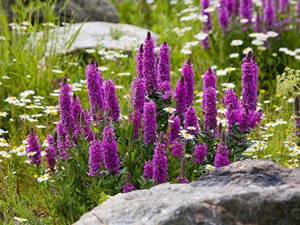
Adenophora
The flower belongs to tall perennials from the bellflower family. About 50 species of these tall perennial flowers are known; they are also called bells. They stretch up to 150 cm.
The plant has narrow leaves growing on numerous long stems. They end in paniculate inflorescences consisting of small drooping bells.
The most common types of bells are: lily-leaved, three-pointed, four-leaved, broad-leaved. These tall perennials grow well in sunny or lightly shaded areas. Adenophora is a drought-resistant plant; it does not tolerate waterlogging. Neutral soils are considered the most suitable.
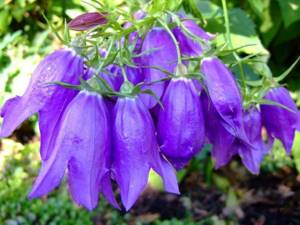
Oregano
Oregano is a tall perennial that grows almost throughout Russia. The rhizome of the plant is thick, the stems are branched, softly pubescent, and reddish in color. The flowers are small, pink-purple, with a pronounced fragrant aroma. They are grouped into corymbose inflorescences. The plant blooms throughout July–August.
Oregano grows in well-drained soils. You need to choose sunny and semi-shaded areas for planting. Oregano leaves are oblong and dark green in color. They show pronounced veins. The stem is hairy, straight, branching towards the apex.
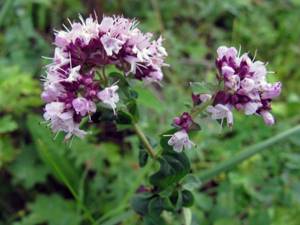
Tritsirtis
When choosing tall perennials based on photos with names, it is difficult not to pay attention to perennial ornamental plants belonging to the lily family.
Comment! Due to the interesting shape of the flower, Tricyrtis is called a garden orchid.
Tricyrtis varieties called stoloniferous, hairy, beautiful, long-legged, short-haired have lanceolate-oval leaves and white-pink flowers, along which there are dark crimson spots. Inflorescences with flowers are collected in bunches in the axils of the leaves and on the tops of the stems. But they do not tolerate cold winters well.
Slightly pubescent and broad-leaved Tricyrtis are considered more frost-resistant. Their buds are yellow in color and are grouped at the tops of the stems. Abundant flowering is observed in mid-summer.
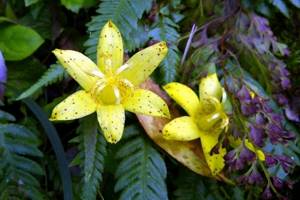
Basilisk
It is difficult not to notice plants with inflorescences that resemble balloons in appearance. A distinctive feature of the flower is the absence of petals. Sometimes they are confused with overgrown sepals.
Basil flowers are decorated with long, numerous stamens. Thanks to their presence, the inflorescences look light and fragile. The height of the stems, at the end of which there are thyroid inflorescences-panicles, reaches 1.2 m. The color of the flower varies from white to lilac-violet. Basil begins to bloom in June, the flowering period is 35 days. The purple and white tall perennial flowers have a pleasant aroma that attracts insects.
The narrow-leaved cornflower has an erect stem, the leaves are pinnate, oblong, thread-like, and slightly pubescent on the underside. Small buds are grouped into pyramidal panicles with golden stamens.
Narrow-leaved basil leaves bloom in mid-June. Flowering lasts at least 40 days. By August-September the seeds begin to ripen.
Basil plants are not picky about growing conditions, but they bloom better in fertile soils. Most species of these tall perennials are characterized by increased moisture-loving properties. In dry weather, watering is required.
Comment! Basil leaves go well with other moisture-loving plants; many prefer to plant them in large tracts.
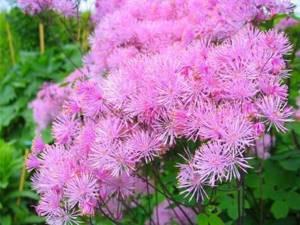
Day-lily
In nature, there are more than 25 varieties of daylily. These flowers grow up to 80 cm in height. Daylily buds form throughout the summer, but each of them blooms for no more than 1 day. They bloom in the morning and fade by evening. But there are varieties in which the flowers bloom in the evening and last for a day. Thanks to the constant formation of new buds, daylily blooms over a long period. There can be up to 30 buds on 1 peduncle.
Daylily is considered a godsend for beginning gardeners. This garden tall perennial does not need special care. It does not require watering and can be planted on any soil. But sandy soils require additional moisture. In hot regions, it is recommended to mulch the soil. To improve flowering, it is recommended to use mineral and organic fertilizers.
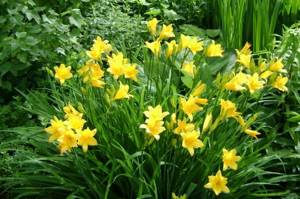
Related Posts
There are no similar entries.
Delphinium hybrid
Another type of rather rare perennial, tall, flowering plants. It includes more than 350 varieties, with different flower colors. This flower belongs to the ranunculaceae family. The height of its stems in some cases exceeds 2 m. The most beautiful representatives of “Delphinium hybrid” are shown below.
Delphinium Galahad
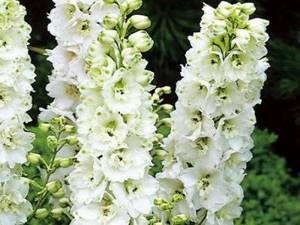
This variety can be called a beautiful tall giant, since the height of its lush white flowers can exceed 2 m. The diameter of the double inflorescences shown in the photo above can reach 7 cm. The shape of the inflorescences is cone-shaped, and the length is at least 80 cm. Such plants are of amazing scale and beauty for sure can become a real decoration of any garden.
Delphinium chinensis
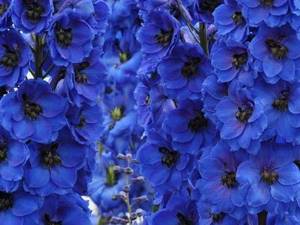
Excellent, deep blue color is the hallmark of the variety. The stems of this perennial are quite tall, up to 80 cm. The flowers, collected in cone-shaped inflorescences, are quite large, due to which the variety has the second name “Delphinium grandiflora”. The plant pleases with its flowering in July-August. The culture is highly resistant to frost and does not require shelter for the winter.
Important! The life cycle of "Chinese Delphinium" is 3-4 years, after which the plant ages and dies. Repeated propagation of this variety is possible by sowing seeds.
It is worth noting that delphiniums, depending on the variety, can have different colors. At the same time, admirers of color diversity should prefer the “Garden Delphinium” variety, which will decorate the landscape with all shades of the rainbow.

Perennials blooming in spring: Canadian aquilegia
Charming catchments have always been considered indispensable in the design of shaded areas. Bringing mystery and special magic, charming pillows of carved leaves and flowers similar to elf caps will not spoil any design. But among the aquilegias there are also genuine stars - unusual, magnificent and surprisingly bright. One of these stars is the North American Aquilegia canadensis
Unlike hybrid ordinary aquilegias, the Canadian one cannot boast of much variety. These plants are usually colored in red-brown shades and create fairly large bushes with easily recognizable, brightly colored leaves.
In our country, in addition to the base plant, only one variety is widespread - “ Little Lanterns” with a bright orange-red color of flowers in multi-flowered inflorescences. And one decorative form is “Nana” (subsp. Nana), shorter and earlier flowering than ordinary Canadian aquilegias.
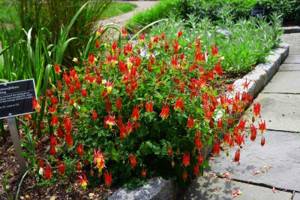
Aquilegia canada "Little Lantens".
Aquilegia canadensis is a fairly large and fast-growing herbaceous perennial with bushes up to 80 cm in height. The powerful root system does not suppress other crops, but allows the formation of spreading, wide, dense bushes and beautiful dense tracts.
Reddish or green, the shoots are very thin and resistant. Twice trifoliate, with a rich, bright dark green color, glowing with light green shades in the sun, with a bluish reverse side, the leaves of this aquilegia seem surprisingly lacy.
Single, up to 4-5 cm in diameter, drooping, with a long spur and pointed petals, the flowers seem narrower than those of the usual aquilegia. The uniquely muted, scarlet, brick shades of the red color of the sepals are emphasized by the yellow petals and yellow stamens hanging from the throat.
The flowering period of Canadian aquilegias occurs at the end of the calendar spring and lasts only 1 month. Depending on the weather, the first flowers bloom in mid or late May. At the beginning of spring, the amazing bright shades of young greenery seem to be no less valuable decoration of the front garden than the flowering that follows.
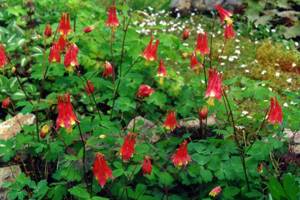
Aquilegia canada "Nana".
Aquilegia canadensis places very noble accents in compositions, elegant, bright and conspicuous. It is especially good in the company of stones and in cool, secluded places, amazingly emphasizing the beauty of evergreen crops and plants with elongated, sword-shaped and linear leaves.
Mallow
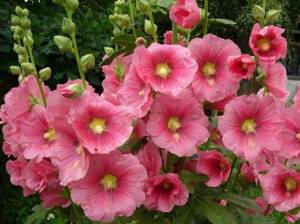
The flowers of the mallow family are quite common. Sometimes they can be found under the following names: rose stock, mallow, kalachik. There are more than 30 types of these flowers. Among them there are perennial varieties.
Musk mallow

A perennial flowering plant, the height of which reaches 1 m. The flowers of this variety are pale pink and exude a pleasant aroma. They tightly cover a long peduncle. The diameter of each delicate flower is 5 cm.
Mallow wrinkled
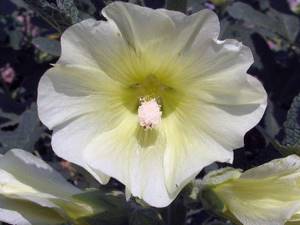
This variety of mallow is very tall: peduncles reach 2 m. The flowers are pale yellow in color, their diameter is approximately 3 cm. Plants can be planted to decorate fences, as well as to create various flower arrangements.
What flowers are sown in open ground in April
In the second half of the month, seeds of plants such as calendula, iberis, summer adonis, arctotis, gaillardia, garden hibiscus, gypsophila, coreopsis, cosmos, lavatera, sweet peas, viscaria, vaccaria, ornamental cabbage, clarkia, annual cornflowers, Chinese carnation, annual rudbeckia, phacelia, nicandra, matthiola, poppy, lobularia, godetia, dimorphotheca, snakehead, bristle grass, bentgrass, mignonette, scabiosa, nigella, flax, malcolmia, canary grass, eschscholzia, echium and other cold-resistant annuals and perennials.
In areas with a cold and long spring, it will be possible to sow the seeds of these flowers in the ground only in May, but it is better to sow them in March or April for seedlings, and in May plant the seedlings in the ground, where, under favorable weather conditions, they will bloom almost immediately. In this article we will tell you how to sow some of the listed annuals, as well as general care rules for these flowers.
morning glory
This beautiful vine with gramophone flowers prefers places protected from the wind and loose soil. Before sowing, morning glory seeds are soaked for a day in a thermos with warm water to swell. Those seeds that have not swelled are pricked with a needle and again immersed in warm water for a day. Instead of water, you can use an aqueous solution of Kornevin or Heteroauxin. It is easy to sow large morning glory seeds: place two seeds in each hole, then fill the holes with soil and water them, after which the flowerbed is mulched with peat. If the forecast predicts frost, the crops are covered with film.
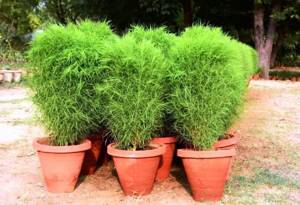
Eschszolzia
This plant, also called the California poppy, is unpretentious, easy to grow and easy to care for. Eschscholzia is photophilous, grows on drained soils of almost any composition, but with a neutral or slightly alkaline reaction, blooms from June to September.
Sow Eschscholzia seeds, stored over the winter in the vegetable drawer of the refrigerator, lightly pressing them into the soil, after which the area is watered and mulched with peat. Some gardeners sow seeds on melted snow, after which they cover the crops with mulch. Shoots usually appear after 2 weeks and require immediate thinning - the optimal distance between seedlings should ultimately be 20 cm.
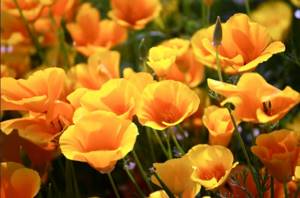
Sweet pea
This plant is also called China fragrant. It is one of the most beautiful climbing annuals. Sweet peas grow well in windless, sunny or slightly shaded areas. Please note that sudden changes in temperature can cause the plant to drop buds. The soil for peas requires fertile, breathable, neutral reaction. It is unacceptable to grow the plant in places with high groundwater levels. When preparing a flower bed, never use fresh manure as fertilizer. Sweet peas do not need nitrogen either - they extract it from the air themselves.
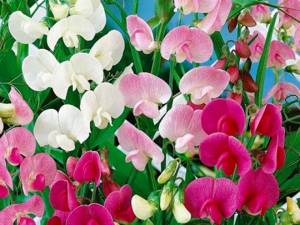
Sow seeds 2-3 pieces in holes located at a distance of 20-25 cm from each other, cover them with soil, compact it and mulch the area. Sweet peas sown in the ground will bloom by mid-summer.
Calendula
This flower gained popularity back in the days of the ancient Greeks and has not lost it to this day. Calendula not only decorates the summer flower bed, but is also one of the most healing plants. It is grown both by seedlings and by sowing seeds directly into the soil, into which fertilizers are added two weeks before sowing. The scheme for planting calendula flowers is as follows: sowing is done to a depth of 1-2 cm at a distance of 25-30 cm from each other. The interval between rows is 60-70 cm if you grow calendula as an ornamental plant, and 30-40 if it is used as a medicinal plant. In this case, the distance between the bushes can be reduced to 7-10 cm.







